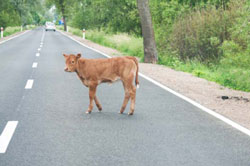Livestock confinement
 Confining livestock, including horses, to your property is important for the safety of the community.
Confining livestock, including horses, to your property is important for the safety of the community.
Wandering livestock can create a serious public safety risk, particularly when they are on roads. Human lives have been lost from vehicle collisions with livestock on roads. Wandering livestock can also injure themselves, other animals they encounter and cause damage to property.
The Impounding of Livestock Act 1994 (IL Act) enables authorised council officers to deal with wandering or inadequately confined livestock.
The IL Act enables a notice of objection to the trespassing of livestock and a notice to confine livestock. This can be served on either a landowner or livestock owner, in relation to trespassing or inadequately confined livestock. Livestock found inadequately confined after a notice to confine has been served, can now be impounded by an authorised council officer if the owner fails to comply with the notice.
The IL Act makes it an offence for a person to allow livestock to wander at large, or to fail to adequately confine livestock to a property. This includes maintaining fencing.
An officer of a council authorised under the IL Act, who finds inadequately confined livestock, may enter any land or building (other than a residence) and impound the livestock in certain circumstances, such as where there is a public safety risk
These powers enable effective measures to be taken to control inadequately confined livestock and help to protect the safety of the Victorian community.
For issues concerning wandering or inadequately confined livestock, call your local council for assistance.
The Impounding of Livestock Regulations 2018 prescribe penalty infringement amounts for specified offences under the IL Act.
Further information about confinement and impounding of livestock, including horses, can be found on this website, by phone on 136 186 or by emailing animal.welfare@agriculture.vic.gov.au.
Virtual fencing for livestock
The Prevention of Cruelty to Animals Regulations 2019 set out when and how electronic collars can be used, sold, hired or supplied for use on animals in Victoria. This includes electronic collars used on livestock for virtual fencing.
Electronic collars are defined in the regulations as an animal collar that is designed to be capable of imparting an electric shock to an animal.
In Victoria electronic collars can only be used on:
- dogs (for the purposes of remote training, anti-bark training or confinement)
- cats (for confinement purposes only)
- cattle, sheep, goats, pigs, camels, alpacas and llamas for research purposes.
Electronic collars cannot be used on any other species.
The use and sale of virtual fencing technology for livestock in Victoria is only allowed for research purposes. There are no limitations on the sale of electronic collars for livestock to purchasers outside of Victoria.
Specific legal requirements relating to electronic collars for livestock
In Victoria a person must not use an electronic collar on livestock unless the electronic collar is used on cattle, sheep, goats, pigs, camels, alpacas or llamas and only as part of a scientific procedure, or program of scientific procedures, approved under a licence granted under Part 3 of the Prevention of Cruelty to Animals Act 1986.
The sale of electronic collars is permitted under the following conditions.
A person must not sell, hire or supply an electronic collar unless they maintain a record of the following details about the purchaser, hirer or recipient of the collar for a period of 7 years:
- the full name of the purchaser, hirer or recipient
- the street address of the property where the electronic collar is to be used
- contact telephone number or email address for the purchaser, hirer or recipient
- the date of sale, hire or supply of the electronic collar
- if the street address is in Victoria then the seller, hirer or supplier must obtain written evidence from the recipient that the electronic collars are only going to be used as part of a licensed scientific procedure.